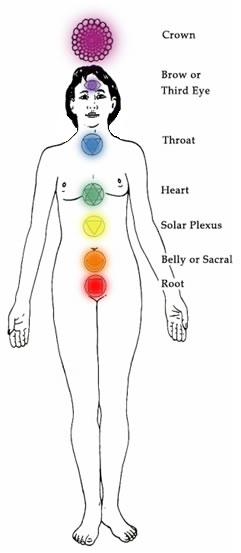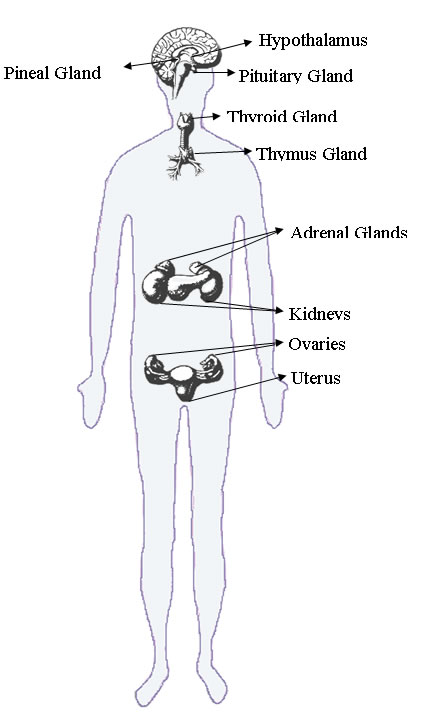The 7 Major Chakras and Reiki
by Angela Gorman, Copyright 2002-2010
 Chakra is a Sanskrit word meaning wheel. It refers to the shape of the energy
Chakra is a Sanskrit word meaning wheel. It refers to the shape of the energy
vortexes that are found in the etheric body of each human being. There are known
to be over 80,000 chakras. A chakra occurs where two energy meridians or channels
intersect. In the western world we concentrate on the seven main chakras. These
chakras are found in a vertical line down the front and back of the central
channel in the energy field.
The thrust of the Reiki energy flows through the central channel. However,
there are many other channels or meridians in our energy field through which
energy flows.
Our mind and our attitudes influence the flow of energy in our energy field.
Each area of the central energy channel and its associated chakra is connected
to a certain focus or way of being. The more balanced our attitudes, the more
balanced the energy distribution in our energy field.
The chakras energetically stimulate a system within the physical body called
the endocrine system. This is comprised of seven major endocrine glands which
produce hormones which are secreted into our bloodstream. The mind also influences
this system through our various attitudes. Balanced attitudes contribute to
a balanced secretion of hormones from the endocrine glands.
Chart of the 7 Chakras
| Chakra | Location | Attitudes | Endocrine Connection | Colour | Element | Musical Note |
| Crown | 2″ above head | Spiritual connection with yourself | Pituitary | Purple | None | B |
| Third Eye | Middle of Forehead | Intuitive Centre Living in the present moment | Pineal | Indigo | None | A |
| Throat | Throat | Communication Speaking Truth | Thyroid / Parathyroids | Blue | Ethers | G |
| Heart | Heart | Unconditional Love | Thymus | Green / Pink | Air | F |
| Solar Plexus | Above the bellybutton and under the breast area | Power Centre Control and Insecurity | Pancreas / Adrenals | Yellow | Fire | E |
| Sacral | Sacrum | Victimization | Ovaries / Testes | Orange | Water | D |
| Root | Base Of Spine | Basic Survival / Sexuality | Adrenals / Sex Organs | Red | Earth | C |
The Endocrine System
The Endocrine System is composed of a group of ductless glands that are not
connected anatomically. Each endocrine gland secretes its own hormone into the
bloodstream. Hormones control a number of processes including: growth, metabolism,
sexual function and stress response.
Pituitary Gland
This is often called the master gland because the hormones it produces stimulate
other endocrine glands. It is situated at the sphenoid bone at the base of the
brain. The pituitary works in close association with another gland in the brain
called the hypothalamus. Feedback between the two helps control hormone production
throughout the endocrine system.
Pineal Gland
This gland is about 1cm long and is found in the forebrain. It secretes melatonin
which is triggered by darkness and is known as the sleep hormone. It is thought
to have an effect on our  moods.
moods.
Thyroid Gland
This gland is butterfly shaped and lies just below the larynx, or voice box.
The thyroid gland has two lobes and is found either side of the trachea. Each
lobe is about 4cm long and 2cm wide. It secretes the hormones thyroxin and triiodothyronine
and regulates growth and general metabolism as well as having affecting our
mental wellbeing.
Parathyroid Glands
Embedded in the lobes of the thyroid gland are two pairs of tiny parathyroid
glands. They produce parathormone which helps regulate blood calcium.
Thymus Gland
This gland lies behind the sternum and extends upward into the root of the
neck. It weighs twelve grammes at birth and grows until the individual reaches
puberty, when it begins to atrophy. The thymus is thought to play an important
part in the immune system by producing T-lymphocytes.
Pancreas
The pancreas lies behind the stomach, near the small intestine. Most of it
consists of cells that release digestive enzymes. It also contains clusters
of cells called islets of langerhans. The islets secrete the hormones insulin
and glucagons, which regulate blood sugar levels.
Adrenal glands
These two small, triangle shaped glands sit on top of the kidneys. Each has
two distinct regions, the outer called the cortex and the inner called the medulla.
The cortex produces hormones involved in metabolism and the suppression of inflammatory
responses. In both men and women, the cortex also secretes small amounts of
‘male’ sex hormones, including testosterone as well as a hormone
that regulates blood volume and pressure. By contrast, the medulla manufactures
the hormone adrenaline in response to stress, fear and exertion. This chemical
helps quicken heart rate, increase blood flow, widen lung airways and draw blood
away from internal organs and channel it to the muscles and extremities.
Ovaries
The almond shaped ovaries lie on either side of the uterus, directly below
the opening of the fallopian tubes. The ovaries store egg cells and produce
the female hormone oestrogen and progesterone.
Testes
The male sex organs, suspended in a sac called the scrotum, generate sperm
as well as testosterone.